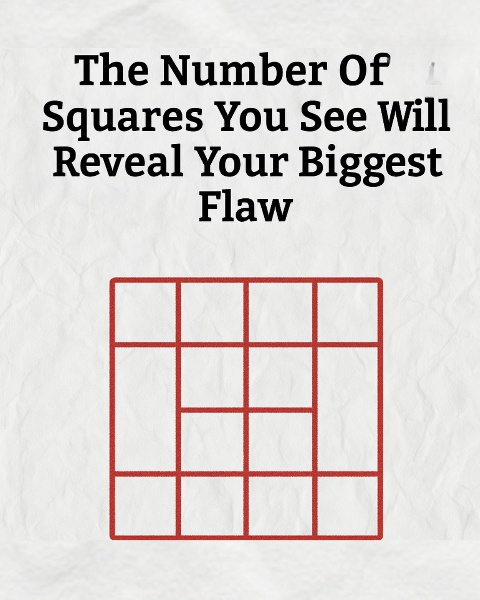Can a simple visual puzzle really expose your biggest flaw? If you’ve spent even a few minutes scrolling on social media, chances are you’ve stumbled across one particular viral meme that asks just that. A grid full of squares with one line of text that reads: “How many squares do you see? The number will reveal your biggest flaw.”
It sounds wild. It sounds like fun. And honestly, it’s kind of addictive. But is there any truth behind it? Or is it just another clever piece of internet bait? Let’s break it down and explore what’s really going on when your brain tackles this puzzle.
The Puzzle Everyone’s Talking About

The meme is simple but sneaky. It shows a big square made up of smaller squares, some overlapping, some hiding in plain sight. People are asked to count how many squares they see. Then comes the catch — the number you land on supposedly reveals something deep about your personality.
Maybe it says seeing 16 squares means you’re impulsive. Maybe 25 means you’re an overthinker. Maybe spotting more than 30 means you’re a control freak. The “results” vary, but the idea is always the same: your count equals your character flaw.
But let’s be real — can a few lines and boxes really uncover your deepest flaw? Not exactly.
Why People Get It Wrong So Often
This puzzle plays tricks on your brain. Most of us are wired to find the obvious patterns first — the single squares, the ones that pop out. What we usually miss are the overlapping combinations, the subtle groupings that only become clear when you slow down and really study the image.
Many people rush through it, trust their first impression, and stop counting too early. Others go overboard and start seeing shapes that don’t exist. The truth? It’s not about how flawed you are — it’s about how closely you pay attention.
Let’s Solve the Puzzle Together
Step by step, here’s how you should count the squares.
First, start with the smallest units — the individual 1×1 squares. In a 4×4 grid, that’s 16 right there.
Then look for 2×2 squares. These are made up of four 1×1 blocks and usually appear in the middle sections. There are 9 of them.
Video : How many squares are in the figure below ?
Next up: the 3×3 squares. These cover more area and are easier to overlook. There are 4 of those.
Finally, don’t forget the big square made up of everything. That’s one more.
If you’re really observant, you’ll also notice the overlapping squares formed by different groupings of smaller squares. These bonus combinations bring the total up — sometimes to 30 or more.
What’s Really Going On In Your Brain
You’re not just seeing shapes — your brain is actively building them based on what it expects to see. This is called top-down processing, and it’s how our brains fill in gaps to create a complete picture from incomplete information.
It’s why you might see a square even when only parts of it are visible. Or why someone else might not notice it at all.
It also explains why the number you end up with isn’t a fixed answer. It depends on your focus, your patience, your visual strategy, and even your mood.
The Real Psychology Behind This Meme
So why are we so drawn to it?
Because it promises instant insight. It’s fast, it’s clickable, and it makes you feel like you’ve learned something meaningful about yourself — even if the result is just a random label.
This is where the Barnum Effect comes into play. It’s the psychological phenomenon where people believe vague, general statements apply specifically to them. So when a puzzle tells you “seeing 24 squares means you’re too sensitive,” your brain looks for confirmation, not contradiction.
Is This About Flaws, Or Just Focus?
Let’s be honest — a meme can’t define your deepest personality flaw. What it can do is show you how your brain handles patterns, distractions, and visual tasks. That’s it.
But here’s the cool part: how you approach the puzzle might say something about you.
Did you rush it? That might reflect a tendency to act quickly.
Did you double-check? Maybe you’re detail-oriented.
Did you give up halfway? That could point to frustration tolerance.
So the flaw isn’t revealed by the number of squares — it’s revealed by your process.
Why We Crave Instant Self-Discovery
Video : How Many Squares Can YOU See?
In today’s world, we want everything fast — including insight into who we are. That’s why quizzes, personality tests, and viral puzzles go crazy online. They promise depth without effort. But self-discovery doesn’t work like that.
Real self-awareness takes time, honesty, and reflection. The meme is just a conversation starter — a doorway, not a destination.
How to Make It Actually Useful
Don’t dismiss the puzzle completely. Use it to spark something deeper. Ask yourself:
Did I notice more after a second look?
Was I frustrated or curious?
How did my approach compare to others?
That reflection — not the meme — is where the insight lives.
Final Thoughts: You Are Not a Number
The number of squares you saw doesn’t define your flaws. It doesn’t decide your future. But it can be a fun way to start asking bigger questions.
Like how do I process information?
How do I react when I’m unsure?
Do I look deeper, or do I stop at the surface?
If a puzzle gets you thinking like that, it’s already more powerful than it seems.
So go ahead. Count the squares. Share the meme. Laugh about your “flaw.” But don’t let the grid define you. You’re more than a meme — you’re a work in progress.
And no square will ever fully capture who you are.


